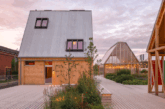
David Broom, Director of Sales at Kensa gives a practical guide to installing networked ground source heat pumps
From system design to borehole drilling to handover, this guide shares expert insights from Kensa on networked ground source heat pumps. Whether it’s for fifty, five hundred, or a thousand homes, this information will help developers understand the gamechanging technology Kensa and GTC are delivering that will be commonplace across future UK housing developments.
Networked ground source heat pumps are a proven technology, that consists of a compact in-home heat pump, such as the Kensa Shoebox NX, typically housed in a cupboard under the stairs, connected to a hidden underground network that supplies multiple dwellings with the renewable energy used for producing heating and hot water. With no external kit and nothing needed above ground on the development, the finished result looks much like a traditional gas-heated property, but with zero on-site CO₂ emissions.
The shared underground infrastructure, known as the ground array, consists of multiple boreholes and pipework. This is usually installed in the early stages of a development, ideally within the adoptable highway. This approach gives each home its own highperforming ground source heat pump at a lower cost per property than installing standalone systems and avoids any costly grid upgrades and associated delays.
Step 1: Design & pre-installation planning
Before the first hole is drilled, the most important part of the process takes place: the system design. During this, experienced designers will use the development plans to map out everything from borehole location and geology to each home’s heating and hot water demands – deciding exactly how many boreholes, their depth and which heat pumps are needed for each home. Key elements that influence this are:
- Building design: how much heat and hot water each property needs, based on size, layout, and fabric performance.
- Site conditions: the geography and geology, including any rock formations, mining history, and water levels.
- Development layout: plots, highways, and the location of integrated green spaces.
With this information, Kensa’s borehole designers develop the heat pump specification and the size and layout of the ground array, working closely with the developers and architects.
Step 2: Borehole drilling
Once the system design is complete, borehole drilling can begin. This is usually early in the development and can run alongside other on-site work.
Boreholes are typically drilled at a rate of 2-2.5 per week, to depths of 120m- 200m, as per the system’s design. They are then lined with 40mm HDPE U-tubes and filled with thermally conductive grout, before being capped, ready for the next phase of the installation when the homes are further along.
Drilling rates and timings include drill rig mobilisation and demobilisation. However, all this can be flexed to match the developer’s desired build rate and other construction works. The UK has plenty of experienced borehole drillers, including Kensa’s in-house drilling service, Kensa Drilling.
Step 3: Trenching and network installation
At the next stage, trenches are opened for other utility services such as electricity, water, and broadband, and the horizontal pipework connecting the boreholes to the heat pump network is also installed. This is where Kensa’s partnership with utility providers like GTC can provide real value, allowing all services to be installed in one go and cutting disruption and cost.
Flow and return pipework connects the boreholes to subterranean manifolds, usually located in the same trench. Header pipes can then be fed from the manifold into the plots for each home, directly to the heat pump’s in-house location.
Step 4: Internal installation
Once the home reaches the second-fix stage, the heat pump is installed, usually by the M&E contractor, with support and training provided by Kensa, which is connected to a hot water cylinder. This was all sized during the design phase, ensuring there’s plenty of hot water for the homeowner and that it can match their heating demands.
Small, quiet heat pumps like the Kensa Shoebox NX3, which operates at just 40.5dBA, are ideal for most new homes. These easily fit into a new home design and take up hardly more space than a gas boiler.
Step 5: Commissioning & operation
Once commissioned, each heat pump runs independently, drawing heat from the shared network as and when the user needs it. The system works via a refrigeration cycle, capturing lowtemperature energy from the ground and upgrading it to usable heat.
The system can also deliver ‘passive cooling’, a unique feature of ground source heat pumps. This can support compliance with Part O.
Developments where this might be needed can be added at any stage during the system design phase.
If delivered through Kensa’s partnership with GTC, a private investor will own and maintain the entire system, including the heat pump and infrastructure network, removing developers’ servicing responsibility and offering residents peace of mind.
For developers, there are benefits to going with networked ground source heat pumps:
- No grid upgrades:
Networked ground source heat pumps require no more grid capacity than gas boilers, which means no delays to on-site works waiting for a connection or paying for costly substation upgrades. - Lower capex:
The system can be cheaper to install than gas or air source, especially with multi-utility integration. - SAP/FHS ready:
Networked ground source heat pumps are FHS compliant and can often achieve high EPC ratings without additional PV. - No external kit:
With nothing visible from the outside, it can mean better home aesthetics and no encroachment on garden space.
When people move into their new homes, they get the lowest running costs of any low-carbon system, and a system built to last, with the ground array lasting 100 years and heat pumps over 20 years. If the installation is the Kensa and GTC model, homeowners will also have zero maintenance worries.
Networked ground source heat pumps work across all geographies and housing types. Early design engagement is key, and Kensa and its utility partner GTC can support developers at every stage, giving developers an effective system that works for the homes they’re building and those moving into them.
For more information go to www.rdr.link/dbg027








